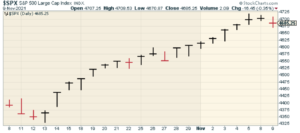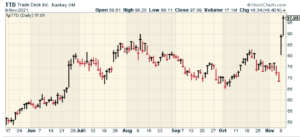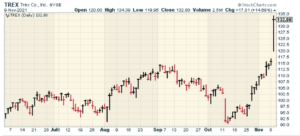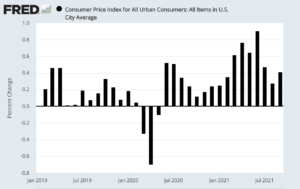CWS Market Review – November 9, 2021
(This is the free version of CWS Market Review. If you like what you see, then please sign up for the premium newsletter for $20 per month or $200 for the whole year. If you sign up today, you can see our two reports, “Your Handy Guide to Stock Orders” and “How Not to Get Screwed on Your Mortgage.”)
On Monday, the S&P 500 did something it hasn’t done in more than 50 years: the index closed higher for the 17th time in 19 trading sessions. That includes a seven-day winning streak followed closely by an eight-day winning streak, the latter of which was snapped today. Also today, the Nasdaq snapped an 11-day winning streak. The last time the S&P 500 went 17-for-19 was 1971.

Many of these recent up days have been pretty small. Twelve of the last 17 daily gains were less than 0.5%, but that’s typical for a rally. Many of the best times for stock investors are fairly dull markets. George Soros once said, “If investing is entertaining, if you’re having fun, you’re probably not making any money.” That’s probably true.
A few years ago, I looked at 60 years of daily market data. I found that if you take all the days when the S&P 500 moved more than 1.14% in a day, up or down, then the combined return comes out to zero. They completely balance each other out. The market’s entire return, more than 55-fold over 60 years, comes on the low-volatility days (up or down less than 1.14%).
The high-volatility days happen 16.5% of the time, or roughly one day in six (just capital gains and not dividends). Historically, it’s been to your advantage to stick with a boring, low-vol market. To be a successful investor, the real profits are made in small steps.
Over time, the gains add up. In this latest 19-day run, the S&P 500 gained 8%. Going back to early March, the S&P 500 is up close to 25%. Bear in mind how many scary headlines there were.
The Trade Desk Rallies 42% in Two Days
Having said that, let’s look at some gigantic one-day returns. Six months ago, I highlighted The Trade Desk (TTD) for you after it had plunged 26% in one day. When good stocks get creamed, most people run away. For me, a rotten day gets my attention. At the time, I wrote: “Thanks to yesterday’s train wreck, this sounds like a good opportunity to take a closer look at this stock that’s still not very well-known.”
The Trade Desk is up 88% since then. Thanks to a very good earnings report, the stock jumped almost 30% yesterday, and it added another 9% today. For Q3, The Trade Desk earned 18 cents per share. Wall Street had been expecting 15 cents. Quarterly revenue rose 39% to $301.1 million. Wall Street had been expecting $283.5 million.

It’s an interesting company. Think Don Draper meets Jeff Bezos. The Trade Desk markets a software platform that’s used by digital ad buyers to build data-driven advertising campaigns. In other words, they help companies get the most bang for their buck on the web.
The Trade Desk offers a real-time bidding technology platform that allows media buyers to target specific audiences with customized ads. Users can manage their digital ad campaigns in real time. They can even use third-party data to optimize their strategies. This saves a lot of time and money for companies’ media strategies.
There’s been some misunderstanding about The Trade Desk’s business. That’s because some investors seem to think that it can easily be blown out by giants like Google or Facebook. That’s not true and this highlights the key difference that The Trade Desk offers. If a company wants to advertise with, say, Google, then they go to Google. If a company wants to advertise with Facebook, then they go to Facebook.
But if a company wants to use The Trade Desk, then it can tell them that the best and most cost-effective place for them is The New York Times or The Wall Street Journal or Hulu or any number of places.
The numbers for The Trade Desk are very impressive. The company’s gross margins typically run close to 80%. In other words, they can charge five times what it costs them.
The company also provided optimistic guidance. For Q4, The Trade Desk sees revenues of at least $388 million and $175 million in adjusted EBITDA. Both numbers were above expectations. I expect to see more good news from The Trade Desk.
Trex Soars 15% on Strong Earnings
The Trade Desk isn’t on our Buy List but Trex (TREX) is and it had a very good day today. Shares of Trex gained 14.7% in today’s session to reach a new all-time high.
Trex reported Q3 earnings of 64 cents per share. That was six cents higher than expectations and 73% higher than a year ago. Quarterly sales rose 45% to $336 million.
If you’re not familiar with the company, Trex is a major maker of wood-alternative decking and railing. In my opinion, what they make looks a lot like wood, but it’s cheaper and involves a lot less maintenance.
Trex is also better for the environment. Pressure-treated wood still dominates which means there’s plenty of room for Trex to grow. It’s also nice to know that with Trex, you don’t have to take another tree out of the Amazon rainforest to make your backyard deck.
Check out their products at their homepage (www.trex.com), and you’ll see why Trex has become so popular.

Trex is made from 95% recycled material. Every year, the company effectively takes 500 pounds of plastic out of landfills and uses it for alternative wood. It’s not just good for the planet, but it’s smart business. Trex takes all those used bags and bottles, then combines it with recycled sawdust from cabinet and furniture manufacturers, and that’s what Trex is made of. By the way, this also saves a lot of water.
Some other key advantages are that Trex weighs less than wood and that it’s also more resistant to mold and insects. You don’t need expensive staining or sanding, and repairs are much less frequent. You’ll often hear people say that Trex looks fake. I think that used to be true, but it’s much less the case today.
Commercial railing is another big business for Trex. Their railings are especially common at stadiums and arenas across North America. Trex is sold in 40 different countries and over 6,700 retailers.
It’s a very efficient business. Trex doesn’t carry a dime in long-term debt and its operating margin runs about 25%. We first added Trex to our Buy List at the beginning of last year. Since then, the stock has surged 195% for us. That means it’s nearly a three-bagger in just two years! Trex now sees Q4 revenue of $295 million to $305 million. The midpoint is up 31% from last year’s Q4.
That reminds me – if you want to get all of our investing insights, don’t forget to sign up for our premium newsletter. It’s $200 for the entire year, or $20 per month if you want to see what it’s like.

Will Inflation Really Be Transitory?
Tomorrow morning, the government will report on consumer inflation for October. This will be a key report to watch because inflation has heated up this year. Earlier this year, we had the highest core inflation report in 40 years.
The Federal Reserve has said that the recent run of inflation will be “transitory.” That’s become the central bank’s latest favorite word.
I don’t know if the Fed is right about that, but I tend to be an empiricist on these issues. The latest figures show that some of the recent inflation has cooled off, but it’s too early to declare victory.
Inflation is very damaging to capital markets. Once it gets embedded in consumer expectations, it’s hard to shake loose. It’s basically a tax on capital and it punishes savings.

Inflation also has an unusual impact on earnings. First, you have to understand that not all earnings are the same. Inflation exacts a heavy toll on asset-heavy businesses. As a result, companies with high assets relative to their profits tend to report ersatz earnings.
Inflation has an impact similar to putting a magnet near a compass. Investors who remember the 1970s certainly remember how unpleasant persistent inflation can be. During the entire decade of the 1970s, the Dow gained a grand total of 38 points.
While inflation has been bad for stocks, equities have a higher threshold than many people realize. I found that inflation doesn’t put the squeeze on stocks until it gets over 5%. Inflation over 5% tends to wreak havoc on the stock and bond markets. You’ll see consumers change their behavior. For example, Walmart (WMT) did very well during the 1960s and 1970s as it became known for its low prices. I suspect that inflation will gradually subside but I won’t be convinced until the data confirms it.
That’s all for now. I’ll have more for you in the next issue of CWS Market Review.
– Eddy
P.S. Don’t forget to sign up for our premium newsletter.
Posted by Eddy Elfenbein on November 9th, 2021 at 7:05 pm
The information in this blog post represents my own opinions and does not contain a recommendation for any particular security or investment. I or my affiliates may hold positions or other interests in securities mentioned in the Blog, please see my Disclaimer page for my full disclaimer.
- Tweets by @EddyElfenbein
-
-
Archives
- May 2024
- April 2024
- March 2024
- February 2024
- January 2024
- December 2023
- November 2023
- October 2023
- September 2023
- August 2023
- July 2023
- June 2023
- May 2023
- April 2023
- March 2023
- February 2023
- January 2023
- December 2022
- November 2022
- October 2022
- September 2022
- August 2022
- July 2022
- June 2022
- May 2022
- April 2022
- March 2022
- February 2022
- January 2022
- December 2021
- November 2021
- October 2021
- September 2021
- August 2021
- July 2021
- June 2021
- May 2021
- April 2021
- March 2021
- February 2021
- January 2021
- December 2020
- November 2020
- October 2020
- September 2020
- August 2020
- July 2020
- June 2020
- May 2020
- April 2020
- March 2020
- February 2020
- January 2020
- December 2019
- November 2019
- October 2019
- September 2019
- August 2019
- July 2019
- June 2019
- May 2019
- April 2019
- March 2019
- February 2019
- January 2019
- December 2018
- November 2018
- October 2018
- September 2018
- August 2018
- July 2018
- June 2018
- May 2018
- April 2018
- March 2018
- February 2018
- January 2018
- December 2017
- November 2017
- October 2017
- September 2017
- August 2017
- July 2017
- June 2017
- May 2017
- April 2017
- March 2017
- February 2017
- January 2017
- December 2016
- November 2016
- October 2016
- September 2016
- August 2016
- July 2016
- June 2016
- May 2016
- April 2016
- March 2016
- February 2016
- January 2016
- December 2015
- November 2015
- October 2015
- September 2015
- August 2015
- July 2015
- June 2015
- May 2015
- April 2015
- March 2015
- February 2015
- January 2015
- December 2014
- November 2014
- October 2014
- September 2014
- August 2014
- July 2014
- June 2014
- May 2014
- April 2014
- March 2014
- February 2014
- January 2014
- December 2013
- November 2013
- October 2013
- September 2013
- August 2013
- July 2013
- June 2013
- May 2013
- April 2013
- March 2013
- February 2013
- January 2013
- December 2012
- November 2012
- October 2012
- September 2012
- August 2012
- July 2012
- June 2012
- May 2012
- April 2012
- March 2012
- February 2012
- January 2012
- December 2011
- November 2011
- October 2011
- September 2011
- August 2011
- July 2011
- June 2011
- May 2011
- April 2011
- March 2011
- February 2011
- January 2011
- December 2010
- November 2010
- October 2010
- September 2010
- August 2010
- July 2010
- June 2010
- May 2010
- April 2010
- March 2010
- February 2010
- January 2010
- December 2009
- November 2009
- October 2009
- September 2009
- August 2009
- July 2009
- June 2009
- May 2009
- April 2009
- March 2009
- February 2009
- January 2009
- December 2008
- November 2008
- October 2008
- September 2008
- August 2008
- July 2008
- June 2008
- May 2008
- April 2008
- March 2008
- February 2008
- January 2008
- December 2007
- November 2007
- October 2007
- September 2007
- August 2007
- July 2007
- June 2007
- May 2007
- April 2007
- March 2007
- February 2007
- January 2007
- December 2006
- November 2006
- October 2006
- September 2006
- August 2006
- July 2006
- June 2006
- May 2006
- April 2006
- March 2006
- February 2006
- January 2006
- December 2005
- November 2005
- October 2005
- September 2005
- August 2005
- July 2005
 Eddy Elfenbein is a Washington, DC-based speaker, portfolio manager and editor of the blog Crossing Wall Street. His
Eddy Elfenbein is a Washington, DC-based speaker, portfolio manager and editor of the blog Crossing Wall Street. His